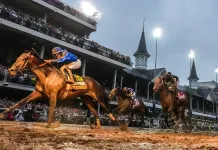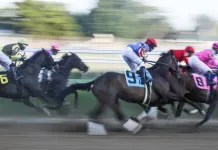Las Vegas
Seriously, Kentucky Downs deserves better.
The track that has the lowest blended takeout rate in the country, that consistently has full fields, that showcases the purity of agrarian turf racing, that provides an end-of-summer picnic setting, that brings “A” list jockeys and trainers and horsemen back to the roots of the sport ought not to have the bad luck it has had this week.
This goes beyond sticky hot weather and the curse of COVID-19. The past few days have been worse than a late back-door cover that seems meaningless everywhere but here in Nevada and 17 other states.
Stop. Do not declare this to be another sign of how bad 2020 is. That has become the crutch angle lately to every story built around bad news. A favorite lost a horse race? Blame it on 2020. Wedding got postponed? Yeah, 2020. The dog tracked mud onto the carpet? Gotta be 2020. (Admission: I used this angle in my Kentucky Derby story. But that was last weekend. Only after Labor Day did it formally become déclassé to make comparisons to 2020. And to wear white.)
Kentucky Downs is on my bucket list. Truth be told, had I gone to the Derby last week, I was invited to drive down this week to the old Dueling Grounds on the Kentucky-Tennessee border and do a little extra work for the racetrack. But the reality of … , um, 2-2- got in the way.
First came opening day Monday, when the starting gate sprung open for the fifth race before all the horses were loaded. Insiders said that it was because a new battery to power the gate did not hold its charge; electricity keeps the stalls closed until the juice is cut. Track management paid each of the 12 owners $5,000 and each of the 12 jockeys $500. The $66,000 came from the purse fund; the race would have been worth $90,000. The other $24,000 may have gone to orange slices.
About 2½ hours later in the 10th race a 2-year-old colt named Snake Doctor, sired by 2013 Preakness winner Oxbow, broke down making an outside move on the far turn and had to be euthanized with an injury to his right front leg. Jockey Ricardo Santana Jr. was all right.
Then came Day 2 on Wednesday. A brand new tractor being used to move the starting gate got stuck in a useless gear just after the start of the fifth race. At 1 5/16 miles the race was not going to end until a little more than one lap later – the key words being “a little more.” Fortunately, a back-up tractor nearby was hurriedly used to tow the gate and the broken-down tractor out of the way just before the horses turned for home. There was no confirmation that the tractor was a replica of the Hoyt-Clagwell used by Oliver Wendell Douglas on the old Haney farm. (Use Geezer Google to look that up.)
Day 3 seemed quiet enough other than the fact that a fifth track record had been broken since the meet began. Something seemed fishy. Then it was reported that starting gate may have been set up in the wrong place. But not this year. For all the years beforehand. Using GPS technology, a new Gmax timing system was used to measure the track, and it is apparently longer than everyone thought. So the gate has been set up this week where it is supposed to be as much as 40 yards forward of its traditional position for the longest races. For now the new records will not count, because the old ones going back more than 30 years may be worthless. Then again it is Gmax, which had its accuracy issues this summer at Del Mar. Just write the records in pencil and have erasers handy.
Oh, there was also a jockey’s objection that led to the taking down of the winner in the last race Thursday. But writing about those things seems superfluous, because social media does such a bang-up job detailing stewards reviews in a calm and rational manner.
Then came Friday, when the oppressive heat that is not unusual for this time of year may have contributed to the power going out in the TV production truck as the horses were about to take the track for the $500,000 Dueling Grounds Oaks. Down went the cameras on which the stewards rely. In came a back-up generator, and the race went on – albeit 34 minutes late. This was oddly reminiscent of last August, when the audio system overheated one day and caused Michael Wrona’s microphone to fail in mid-race.
All these problems may have been mined for cheap comedy. (Was that really me who suggested on my podcast that the malfunctioning gate was lost this week? Guilty.) But I hope this is a case of laughing with and not at everyone at the track 40 miles from Nashville.
Regardless of the problems Kentucky Downs remains popular with bettors. And why not? The average field has had 11.5 entries – not counting the dozens of also eligibles. The smallest field had nine. Nine. That is a good day in southern California.
The six racing days have grown to include 16 stakes worth $8.6 million. The takeout looks shrunken at 16 percent for win-place-show, 18¼ percent for exactas, 15 percent for Pick 4s and Pick 5s and 19 percent for the rest of the exotics.
Horseplayers hoping to treat themselves with winning wagers rewarded Kentucky Downs with $8,983,981 in handle Thursday, the third largest in track history and the biggest it has had on a weekday.
Saturday brings three Grade 3 races, including the $700,000 Turf Sprint Stakes that is an automatic qualifier for the Breeders’ Cup. The race is so wide open that 5-year-old gelding Totally Boss is 9-2 on the morning line. That makes him an uncertain favorite. My money says that trainer Wesley Ward’s former Royal Ascot show finisher Bound For Nowhere (5-1) comes from just off the early pace with jockey Julio García to make up for two narrow losses in his only other starts this year.
Here is hoping that the bad luck is over for Kentucky Downs, what with its rolling turns that make other racecourses around the country look like they were made with cookie cutters. Call it European style turf mixed with a little southern comfort. Or a lot of Southern Comfort.
By the way, I never finished my podcast joke about Kentucky Downs. After finding out that the course distances were wrong all these years, did you hear the one about the malfunctioning starting gate that was missing? It was not lost. It was misplaced.
Racing notes and opinions
Without being specific, Las Vegas sportsbook managers were upbeat about their experiences last week with the Kentucky Derby and Oaks. “All went well,” Station Casinos’ Chuck Esposito said, mirroring the comments of his rivals. “Overall we had decent handle. The outcome was good.” Because of a dispute with Churchill Downs over how to split the takeout, it was the first time in 28 years that Nevada operated outside the nationwide pari-mutuel pools. The racebooks were more at risk because they were committed to paying track odds, so they imposed strict limits on vertical exotics; 150-1 on exactas and 500-1 on trifectas were typical. There was no horizontal multi-race betting. Some bettors who said they won deep exotics went on social media to express their frustration with their limited winnings. A spokesman for the Nevada Gaming Control Board said that verified figures for the Oaks and Derby will not be available until next month.
A House committee voted 46-5 on Wednesday to move forward on the Horseracing Integrity and Safety Act, a bill that had languished on the Congressional shelf before Senate Majority Leader Mitch McConnell, R-Ky., put his power behind it. Now it has wide bipartisan support and endorsements throughout the racing industry. A notable exception is the National Horsemen’s Benevolent and Protective Association, which said it was never consulted nor were veterinarians and horseplayers. In addition to the phasing out of Lasix, the bill calls for the establishment of an independent authority to regulate the medication of horses and to enforce those rules. If the bill continues its fast track across Capitol Hill and gets the signature of President Trump before election day, it would take effect in January 2022.
Circa Sports expects to open its Preakness Stakes futures early next week. Stations and William Hill Nevada have not publicly committed to when they might do so. The last race of this year’s Triple Crown is Oct. 3 at Pimlico in Baltimore.
Ron Flatter’s weekly racing column is posted every Friday morning at VSiN.com. You may also hear the Ron Flatter Racing Pod posted Friday mornings at VSiN.com/podcasts. How can horseplayers interpret thoroughbred sales? What does a new Congressional bill mean for racing? Who will win races this weekend at Kentucky Downs and Woodbine? Bloodstock agent Greg Harbut, National Horsemen’s Benevolent and Protective Association CEO Eric Hamelback and Circa Sports bookmaker Paul Zilm answer those questions on the RFRP, post at Apple, Google, iHeart, Spotify, Stitcher and at VSiN.com/podcasts. It is sponsored by 1/ST BET.





